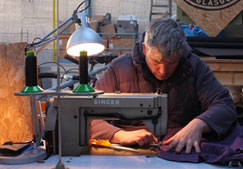There are many reasons to buy more locally manufactured goods. But as Al Dean has recently discovered, the path to a more sustainable future can place a burden on your wallet. So is it
worth it? Absolutely, he says.
Think about the things you’ve spent your disposable income on in the last year or so. Like a lot of people in these financially restricted times, we’re being careful what we spend our money on.
Now consider the things you cherish and enjoy interacting with. I’m not talking about telephones and computing devices, but rather more emotional items like clothing, books, vinyl records (no? just me then).
These are the things you build a relationship with, which evoke a tactile response from. After all, who’s not slipped on that favourite pair of denims and just instantly felt a little more comfortable?
Opposing this is the simple fact that a lot of the things we purchase are, well, if I’m frank, a little bit shoddy these days.
I don’t mean the “We used to make things properly” claptrap that people of a certain generation like to repeat ad nauseum, but rather that the demand for lower cost goods is always going to mean cheaper materials, less craftsmanship and in general, a lot more fixing of things or replacing of them.
When I’m able to buy a toaster for 5 quid from Tescos, you know something has gone horribly, horribly wrong.
So, I took a decision to follow the maxim of “Buy nice not twice”. After all, if we’re all working our socks off, what’s the point in buying something that’s sub-standard just because it’s
cheap. I also decided to try and buy products that are made more locally.
Sustainability is something that’s on a lot of people’s minds but the reality is that economic pressures often override our will to “do the right thing”. Of course, the odds of me being able to purchase a new DVD drive that’s been made in the West Midlands is pretty slim, but where I can, local would be a preference.
Whole world in a bag
I’ll save you the ins and outs of my buying patterns, but the first instance is that my trusty old North Face backpack is giving out.
It’s been stitched by myself as well as by more professional masters of the needle, but still, it’s on its last legs and the last thing I want is a laptop and a camera crashing to the floor unexpectedly on a airport concourse or rail platform.
It was around the same time that I discovered that Trakke make some pretty rugged and practical looking bags.
Targeting the courier industry, Trakke has a small product range of messenger bags and backpacks. Its materials are first class; waxed cotton and Harris tweed, stainless steel hardware.
It feels like the sort of bag you hand on to your kids, rather than replace every two years. And they’re made, by hand, in Glasgow. In fact, there’s a delay in my bag arriving (they’re made to order) because Alec’s team is waiting on a delivery of materials.
Fix up, look sharp
Denims. Some people wear them at weekends, other lucky buggers (like me) get to skip the pleated khakis of the corporate world and get to wear them pretty much 24/7 (or at least, taking them off to sleep).
So, when you wear the same trousers, all the time, you want something that’s nice.
As with all Brits that travel, I’ve got a few pairs of Levi’s knocking about from various trips to the states, but I wanted to try something different.
This led me to a company in Cardigan Bay called Hiut Denim. Started by the founder of Howies, David Hieatt, the company is aiming to bring denim craft back to a town that used to produce thousands of pairs a week until the factories closed.
I just wish I’d paid more attention in that Soft Toy Making class I took as an 8 year old while all my friends went to football school. Things could have been different, man
Hiut’s been going a couple of years, its reputation is growing and from the feel and cut of its denims, it’s destined to be a favourite for many.
But after a couple of pairs, a button popped off them. Not so good eh? I lamented the fact on twitter and before I’d even got a chance to contact them to ask about a repair, I’d got an email from Naomi at Hiut (Now THAT is impressive) offering to send a replacement pair while I sent the offending pair back.
A changing tide
So, what have I learned? Firstly, quality costs a little bit more — but you truly do get what you pay for. If that quality can be found from local sources, without the overheard of container shipping across the planet and from a business run with responsibility in mind as well as commercial sense, then you’re on to a winner.
But that has to be backed up with customer service.
Whatever you think about today’s emerging and changing business environment, there does seem to be a rise of the maker and a return of the cottage industry. This of course means that we’re not reliant on massive buying power of global multinationals to provide our goods.
Independent companies now have a chance to manufacture goods, provide employment and delight their customers — the internet changed that.
I’m aware that these two products aren’t the typical work of DEVELOP3D readers, but I think there’s a lesson here for all of us. Local is good. Custom and well made is good.
But it all has to be wrapped up with something special in terms of design. Whether it’s perfecting the cut of your jeans or the correct placement of buckles and straps.
I just wish I’d paid more attention in that Soft Toy Making class I took as an 8 year old while all my friends went to football school.
Things could have been different, man.
Quality costs more, but you get what you pay for
Default







